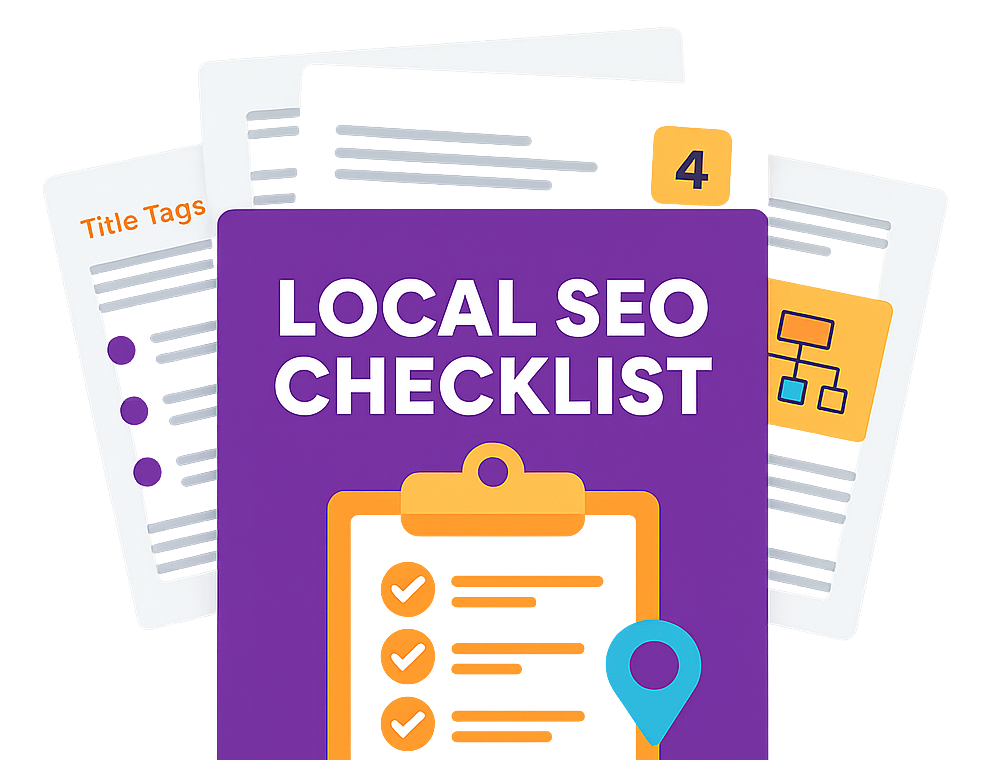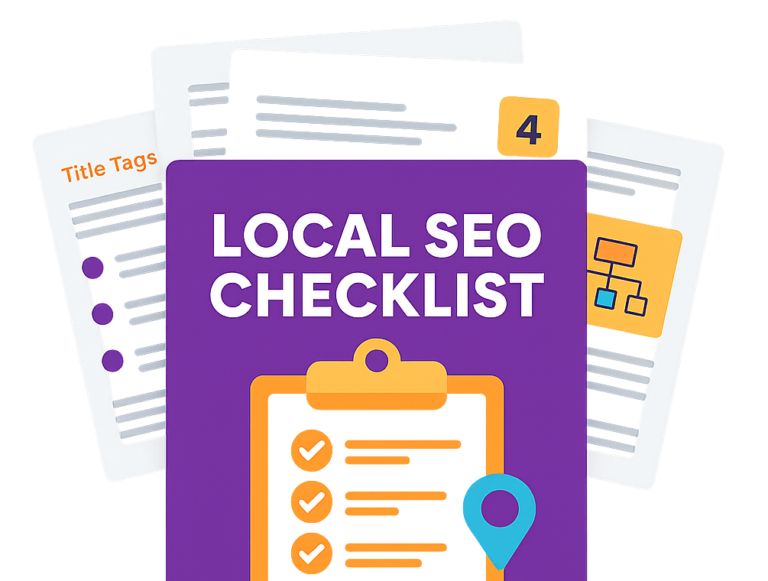Think of schema markup as a secret language you share with search engines like Google. It’s a bit of code you add to your website that translates your content into something search engines can instantly understand.
Instead of just seeing a block of text or a picture, this code tells them, "Hey, this is a recipe," "this is a product review," or "this is an upcoming event." This clarity helps search engines show your content in much more useful and eye-catching ways in their results.
Understanding Schema Markup: A Simple Analogy

Imagine your website is a book. Without any help, a search engine has to read every single word to figure out what it's about. It’s a slow process, and it’s easy for the search engine to get the wrong idea.
Now, imagine that same book has a super-detailed table of contents. It doesn’t just list the chapter titles; it explains what’s inside each one. It points out that Chapter 2 introduces the main character, Chapter 5 contains the big plot twist, and the appendix has a glossary.
That’s exactly what schema markup does for your website. It’s the ultimate cheat sheet for search engines.
Beyond Words to Meaning
Schema is a shared vocabulary developed by the big players—Google, Bing, Yahoo!, and Yandex. The best part? It's completely invisible to your human visitors. It doesn't change how your site looks one bit.
Its only job is to give search engines context. It transforms ambiguous data into clear, actionable facts. For instance, without schema, a search engine sees "Cambridge CB1 1AA." With schema, it understands this is the postal code for a specific local business.
This structured data lets search engines move beyond just matching keywords and start understanding the meaning behind your content and how it all connects.
Why Context Is King
This deeper level of understanding is a game-changer. When Google knows for a fact that a string of numbers is a phone number, a date is an event, or a star rating is for a product, it can feature that information directly on the search results page.
These enhanced listings are called rich results (or rich snippets), and they make your website stand out from the crowd.
Schema markup is essentially a translator between your website and a search engine. It clarifies your content, removing ambiguity and enabling search engines to serve users with more accurate and helpful results directly on the SERP.
The impact is huge. Globally, over 45 million domains have already adopted schema markup to get ahead. Here in the competitive UK market, SEO agencies report that sites using this code can see click-through rates jump by up to 30%. It shows just how critical structured data is for getting noticed. You can discover more insights about schema markup statistics and their impact.
Ultimately, schema markup is a foundational tool for modern SEO. It gives you more control over how you appear in search, making your listings far more attractive and useful to potential customers.
Why Schema Is a Game Changer for Your SEO
Knowing what schema markup is is one thing, but understanding why it's so critical for modern SEO is where the real power lies. Its main job is to unlock rich results—those eye-catching, enhanced search listings that practically jump off a crowded results page.
Think about the last time you searched online for a recipe. Did you click the plain old blue link, or the one showing a five-star rating, the total cooking time, and a mouth-watering photo? That’s a rich result in action, and it’s schema markup working its magic behind the scenes.
These beefed-up snippets turn a standard search listing into a far more compelling preview of what’s on your page. It might seem like a small tweak, but it has a massive impact on how people behave.
Gaining a Competitive Edge in Search Results
On a Google search results page, standing out is half the battle. Schema gives you a clear advantage by making your listing more informative and visually appealing than your competitors'.
Just look at these common examples of rich results, all powered by schema:
- Product Pages: Showing star ratings, the number of reviews, the price, and even stock availability right there in the search results.
- Events: Displaying the date, time, and location for a webinar or concert, giving users the key details instantly.
- Articles: Highlighting the author, when it was published, and a headline image to build immediate authority.
- FAQs: Answering common questions with a handy dropdown toggle, so users can get information without even leaving Google.
Every one of these additions makes it more likely that someone will click your link instead of the one next to it. This is where schema stops being a technical chore and starts driving real business results.
By giving search engines clear, structured context about your page, schema markup lets them build a more useful and attractive search result. This isn't just about looking pretty; it's about proving you're the right answer before the user even visits your site.
This boost in visibility has a direct impact on key performance metrics. When your listing offers more information upfront, you attract better-qualified clicks, which can lead to a much higher click-through rate (CTR). A better CTR signals to Google that your content is a great match for the query, reinforcing your page's relevance. Understanding why schema markup is important for SEO is the first step toward grabbing this competitive advantage for yourself.
Future-Proofing Your Content for the Next Wave of Search
Schema's importance goes way beyond the traditional desktop search. We're moving deeper into an era of voice assistants and AI-driven search, where machines need clean, unambiguous data to function.
When you ask Siri, Alexa, or Google Assistant a question, they need to pull a direct, trustworthy answer from somewhere. Schema markup provides the precise, neatly organised information these systems depend on to find facts, figures, and instructions. By putting schema in place, you’re essentially optimising your content to become the go-to source for these direct answers.
Looking ahead to 2025, schema’s role in the UK is only set to grow, especially as AI-powered search becomes the norm. For many businesses, rich results are already proving crucial for holding onto traffic in a world of zero-click searches. In fact, UK-based SEO experts have seen schema-driven rich results lift click-through rates by anywhere from 15% to 50%, depending on the industry and the type of schema used.
For local businesses, this means getting featured in AI-generated summaries that guide buying decisions—a powerful new way to find customers. This makes adopting schema less of a technical tweak and more of a foundational strategy for staying visible in the years to come.
Exploring the Most Valuable Schema Types
While the Schema.org vocabulary is massive, listing hundreds of different data types, not all of them pack the same punch. For a UK business, the smartest move is to focus on a select few that generate those powerful, eye-catching rich results. These are the markups that turn a standard blue link into a search listing that genuinely stands out.
Let's break down the most valuable schema types, what they tell Google, and how they can really benefit your business. Think of this as your catalogue of the best options for boosting your presence in the search results.
Organisation Schema
First up is Organisation schema. This is foundational. It provides Google with the essential, top-level information about your company: your official name, logo, address, and all the key contact details.
Implementing this schema helps lock in your brand's identity online. It can also be a key ingredient in getting a Knowledge Panel—that big info box that pops up on the right when someone searches for your brand. It’s a huge signal of authority and trustworthiness.
Local Business Schema
For any business with a physical location serving local customers—from a Cambridgeshire café to a high-street shop—Local Business schema is a must. It's basically a more detailed version of Organisation schema, specifically designed for brick-and-mortar businesses.
You can spell out all the crucial details your customers are looking for, such as:
- Your precise address and phone number
- Your opening and closing hours
- Accepted payment methods
- A link to your location on a map
This information feeds directly into Google Maps and local search results, making it so much easier for customers in your area to find and visit you. It’s a no-brainer for local SEO.
Product and Review Schema
For any e-commerce site, Product schema is an absolute game-changer. It lets you embed vital purchasing information directly into your search result, turning it into a mini-advertisement for your item right there on the SERP.
This markup can showcase:
- The product's price (e.g., £49.99)
- Current stock availability (In Stock / Out of Stock)
- An aggregate star rating from customer reviews
- The total number of reviews
When a potential customer sees star ratings and pricing before they even click, they are far more likely to engage. It pre-qualifies their interest and significantly boosts click-through rates by providing the exact information they are looking for.
Closely related is Review schema, which can be used for both individual and aggregated ratings. And it's not just for products; it works for services, recipes, courses, you name it. The visual pull of the gold stars alone is often enough to draw a user's eye away from your competitors.
The infographic below shows how these different schema types can be applied to various online examples, illustrating their versatility.

This visualisation highlights that schema isn't a one-size-fits-all solution; the most effective type depends entirely on the content of the page.
Event Schema
If your business hosts webinars, workshops, concerts, or any other kind of event, Event schema is essential. It lets Google display the key details in a clean, structured format, making your listing far more actionable for users.
Search results can show the event name, date, time, and location, giving people the critical information they need at a glance. This drives up visibility and can directly lead to higher attendance and more ticket sales.
FAQ Schema
Have you ever seen a search result with a series of dropdown questions and answers? That’s FAQ schema at work. This markup is perfect for pages designed to answer common customer queries.
By marking up your questions and answers, you give Google the ability to display them as an interactive rich result. This not only makes your listing take up more precious real estate on the results page but also positions your site as an authoritative source. Users can get their answers right from the SERP, which builds trust and encourages them to click through for more.
The table below gives a quick summary of these popular schema types and the impact they can have.
Popular Schema Types and Their SEO Impact
Here’s a look at some common schema markups, what they describe, and the kind of rich result you might see in the search results.
| Schema Type | What It Describes | Potential Rich Result in SERPs |
|---|---|---|
| Organisation | Key company details like name, logo, and contact info. | Knowledge Panel eligibility, enhanced brand presence. |
| Local Business | Specifics for a physical location: address, hours, map. | Google Maps listings, local pack results. |
| Product | E-commerce item details: price, availability, brand. | Price, stock status, and star ratings directly in results. |
| Review/AggregateRating | Customer ratings and review counts for a product or service. | Gold star ratings that grab attention and build trust. |
| Event | Details for an upcoming event: date, time, location, venue. | An enhanced listing showing key event information. |
| FAQ | A list of questions and their corresponding answers. | Interactive dropdown Q&A section below your main link. |
Choosing the right schema comes down to matching the markup to your page's content. A product page gets Product schema, a contact page gets Local Business schema, and a blog post gets Article schema. By focusing on these high-value types, you can deliver the most relevant information to both search engines and potential customers, getting the best return on your SEO efforts.
Right, you’ve seen what schema can do, so the next big question is pretty obvious: "How do I actually get this code onto my website?"
For a lot of business owners, that question alone sounds like a one-way ticket to a technical headache. But honestly, it's often more straightforward than you might think. Let’s walk through a simple, step-by-step process that doesn’t require you to be a coding wizard.
The secret sauce here is a format called JSON-LD (JavaScript Object Notation for Linked Data). This is Google's preferred method, and for good reason: it’s the easiest to handle. Instead of weaving code into your visible website text, JSON-LD is a neat, self-contained script you just pop into your page’s code. This makes it incredibly clean and simple to add, edit, or remove later on.
Step 1: Choose the Right Schema for Your Page
First things first, you need to play matchmaker. Your goal is to pair the right type of schema with the content on your page. Just think about the page's main job. Is it a blog post? You'll want Article schema. Selling a specific gadget? That’s a job for Product schema.
Here’s a quick mental checklist to get you started:
- Homepage: Use
Organisationschema to tell Google who you are as a business. - Contact Page:
LocalBusinessschema is perfect for your address, phone number, and opening hours. - Product Page: Go with
Productschema and include details like price and availability. - Blog Post:
ArticleorBlogPostingschema is the way to go here. - FAQ Page:
FAQPageschema is designed specifically to mark up those questions and answers.
Getting this right is half the battle. It ensures you’re feeding Google the most accurate and helpful information possible, which is the whole point of this exercise.
Step 2: Generate Your Schema Code (Without Writing It)
Good news: you don't need to learn to code to create schema markup. There are some fantastic free tools out there that will do all the heavy lifting for you. The most reliable one to start with is Google's own Structured Data Markup Helper.
This tool is brilliant. You just pick a schema type, paste in your page's URL, and then visually click and highlight the content you want to mark up. For example, you can click on your article’s title and tag it as the "headline," or highlight the author’s name and tag it as the "author." While you do this, the tool generates the clean JSON-LD code for you on the side. Easy.
Step 3: Add the Generated Code to Your Website
Once the tool has spit out your shiny new JSON-LD script, the next step is to get it onto the right page of your website. The code block will be wrapped in tags that look like <script type="application/ld+json">...</script>.
All you need to do is copy this entire block of code and paste it into the <head> section of your page's HTML.
If you’re using a CMS like WordPress, plugins like Yoast SEO or Rank Math make this even simpler. They often have a dedicated field where you can just paste header scripts. If you’re not comfortable poking around in your site's code, this is a clear and simple task to hand over to your web developer. For more complex custom-built sites, consulting with experienced e-commerce developers can ensure everything is integrated smoothly.
Step 4: Validate Your Code Before It Goes Live
Don't pop the champagne just yet. There’s one final, crucial step: validation. You need to make absolutely sure your code is error-free so Google can read it properly. For this, you’ll turn to another free Google tool, the Rich Results Test.
This tool is your quality control. It scans your code for errors, flags any warnings, and confirms which rich results your page might be eligible for. You can either paste your URL directly into the tool or drop the code snippet in for a quick check.
This is what the Rich Results Test interface looks like – just a simple box to enter a URL to check its structured data.
After running the test, it will give you a clear "Valid" or "Invalid" status and point out any specific issues that need fixing. Job done.
And this isn't just a game for large corporations. A 2024 survey showed that 40% of schema implementation efforts in the UK are carried out by small businesses with fewer than five employees. Interestingly, the same survey found that 57% of users implement schema manually, which can be a recipe for errors. Using tools like the ones I've mentioned is a much safer bet.
Key Takeaway: Adding schema isn't rocket science. It boils down to four manageable steps: Choose the right type, generate the code with a free tool, paste it into your page's head section, and validate it with Google's Rich Results Test.
By following these steps, you can confidently start implementing schema on your own. It's a genuinely practical skill for anyone looking to get more hands-on with their website's performance. And if you're keen to expand your toolkit, you might also want to check out our guide on how to do SEO yourself.
Common Schema Mistakes and How to Avoid Them

Putting schema markup to work is where the real SEO magic happens. But get it wrong, and you can undo all your hard work. While an honest mistake will probably just get ignored by Google, deliberately misusing structured data can land you in hot water, making your pages ineligible for any rich results at all.
To keep your strategy on the right track, you need to know the common pitfalls. Let’s break down the critical mistakes you’ll want to steer clear of.
Mismatching Schema with Content
This is one of the most frequent errors we see. It’s all about applying schema that doesn't accurately reflect what's actually on the page. For instance, slapping Product schema on a category page that lists multiple different products is a classic no-no. That schema type is meant for a single product page, period.
The same goes for using Article schema on a page that’s really just a sales pitch. That’s a violation of Google’s guidelines. Always make sure the schema you choose is the most specific and truthful representation of the page's main content.
Marking Up Invisible Content
This is a huge red flag for search engines. Any content you mark up with schema must be visible to the user on the page. It’s that simple. You can’t, for example, add Review schema with a glowing five-star rating if that review text doesn't actually appear for visitors to read.
Hiding marked-up content is seen as a sneaky tactic. It's a fast track to losing your eligibility for rich results and could even earn your site a manual action penalty from Google.
The golden rule of schema is simple: if a user can't see it, you shouldn't mark it up. Your structured data should enhance and clarify your visible content, not add information that isn't there.
Using Incomplete or Generic Markup
While it’s tempting to add just the bare minimum, providing detailed and specific information is what makes schema so powerful. If you’re marking up a LocalBusiness, don’t just add the name. Go further and include the address, opening hours, and phone number.
Being specific matters, too. If you run a restaurant, don’t just settle for the generic LocalBusiness type. Use the much more specific Restaurant schema instead. The more detail you give Google, the better it understands your content and the more likely you are to be rewarded with a rich result.
These kinds of errors often fall under the umbrella of wider technical issues. In fact, many of the common SEO mistakes small businesses make boil down to a lack of attention to detail, and schema is no different.
Best Practices for Error-Free Implementation
To keep your schema clean, effective, and penalty-free, stick to these guidelines:
- Be Specific and Thorough: Always choose the most precise schema type available and fill out as many relevant properties as you can.
- Ensure Visibility: Double-check that all your marked-up content is clearly visible and easily accessible to your website visitors.
- Follow Google's Guidelines: Make a habit of reviewing Google's official structured data documentation, as the rules and recommended properties can change.
- Validate Everything: Before you publish, always run your code through Google's Rich Results Test. It’s your best friend for catching errors or warnings.
A regular ecommerce SEO audit is a great way to proactively catch and fix any schema-related problems. By building a reliable strategy from the very beginning, you protect your site’s reputation and seriously boost your chances of earning those valuable rich results.
Right, let's pull all of this together. By now, you should see that getting schema on your site isn't some kind of technical dark art. It’s actually a straightforward and incredibly powerful way to have a better conversation with search engines, which leads directly to better visibility and more clicks.
The main takeaway is simple: schema helps Google truly understand what your content is about. That understanding is the key that unlocks rich results, making your website pop on the search results page. The trick is to start with a small, manageable task and build up from there.
The journey into structured data doesn't have to be a giant leap. Start with one page, one schema type, and one clear goal. The momentum you build from that single, successful implementation will pave the way for a smarter, more effective SEO strategy across your entire site.
Your Four-Step Starting Checklist
Ready to take the first practical steps? Here’s a clear, actionable roadmap to get you started with schema markup today. This simple checklist is designed to get you going without feeling overwhelmed.
-
Audit and Prioritise Your Pages: First things first, identify your most important pages. These are usually your homepage, key service pages, top-performing blog posts, or the product pages that bring in the most money. Don't try to boil the ocean.
-
Pick One Page and One Schema Type: Choose just one of those high-value pages to be your guinea pig. Then, select the single most relevant schema type for that page's content—like
LocalBusinessfor your contact page orProductfor your bestseller. -
Generate and Validate Your Code: Use a free tool like Google’s Structured Data Markup Helper to generate the JSON-LD code you need. Before you do anything else, copy that code and run it through the Rich Results Test to make sure it's completely error-free.
-
Implement and Monitor Your Performance: Add the validated code to the
<head>section of your page's HTML. After a few weeks, jump into your Google Search Console performance reports. Keep an eye out for new entries under the ‘Enhancements’ or 'Search Appearance' tabs to see how you're doing.
For those wanting to go even deeper with more hands-on steps, you might find our comprehensive guide to schema markup really helpful. By starting small, you can build confidence and see the benefits for yourself.
Got Questions About Schema Markup?
Even with a clear plan, it's natural for a few questions to pop up when you're diving into a new SEO technique. Let's tackle some of the most common ones to clear the air so you can move forward with confidence.
Is Schema a Direct Ranking Factor?
The short answer is no. Schema markup isn't a direct ranking factor in the same way backlinks or keywords are. But that’s not the whole story.
It plays a powerful indirect role. By getting you those eye-catching rich results, schema makes your search listings more visually appealing and informative. This can seriously boost your click-through rate (CTR).
A higher CTR sends a strong signal to Google that your page is a great match for the searcher's query. Over time, that improved user engagement can absolutely influence your rankings for the better.
Can I Use Multiple Schema Types on One Page?
Yes, and you absolutely should if it makes sense for your content. A single page can have lots of different elements, and you can use different schema types to describe them all.
For example, imagine a blog post reviewing a new gadget. You could use:
- Article schema for the blog post itself.
- Product schema for the shiny new gadget being reviewed.
- Review schema to mark up the star rating you gave it.
The golden rule is to make sure each piece of schema accurately describes content that's actually visible on the page. You can list them as separate JSON-LD blocks in your code – a cornerstone of solid on-page SEO best practices.
What Happens If I Implement Schema Incorrectly?
If you make an honest mistake, don't sweat it. Search engines will most likely just ignore the faulty markup. You won't get your rich results, but it won't tank your rankings either.
A word of caution, though: if you deliberately use schema to mislead users—like marking up glowing 5-star reviews that aren't actually on the page—you’re playing with fire. This could earn you a manual action penalty from Google.
A penalty like that can lead to Google stripping all rich results from your entire site. The takeaway? Always be honest, and always run your code through Google's Rich Results Test before it goes live.
Ready to see how a professional SEO strategy can transform your online visibility? At Bare Digital, we provide a free, no-obligation SEO Health Check to identify your biggest opportunities. Get your custom proposal today and discover how we can help you rank higher and drive more traffic. https://www.bare-digital.com








